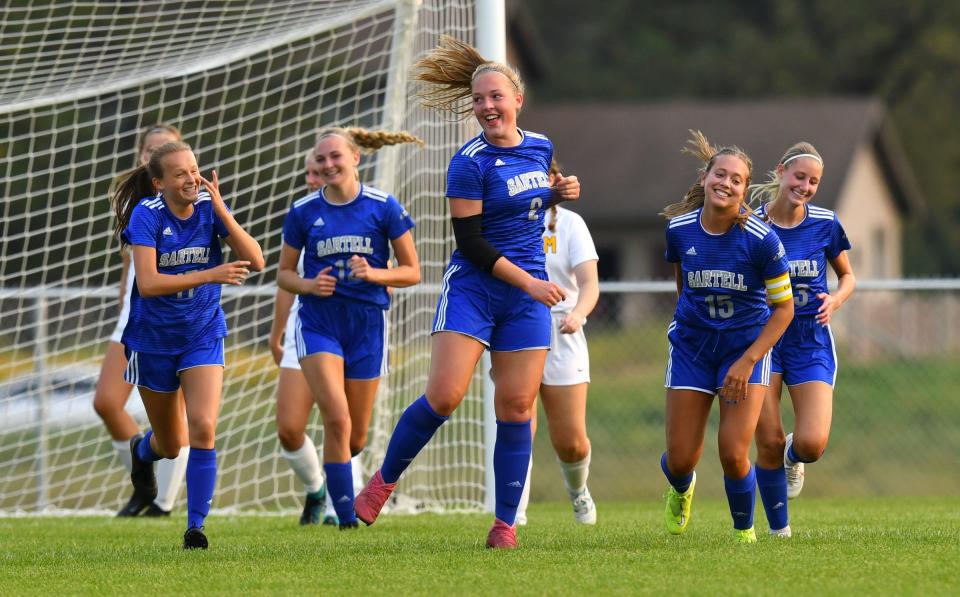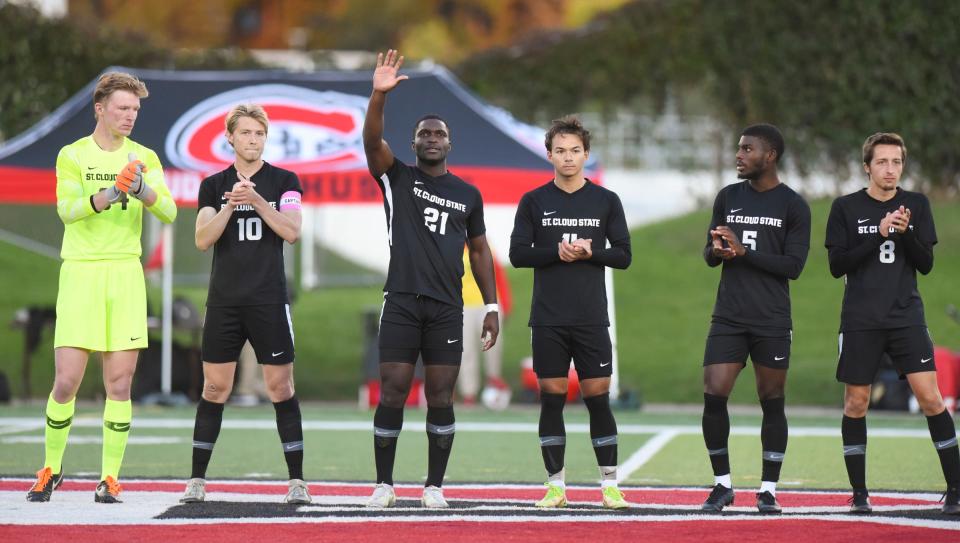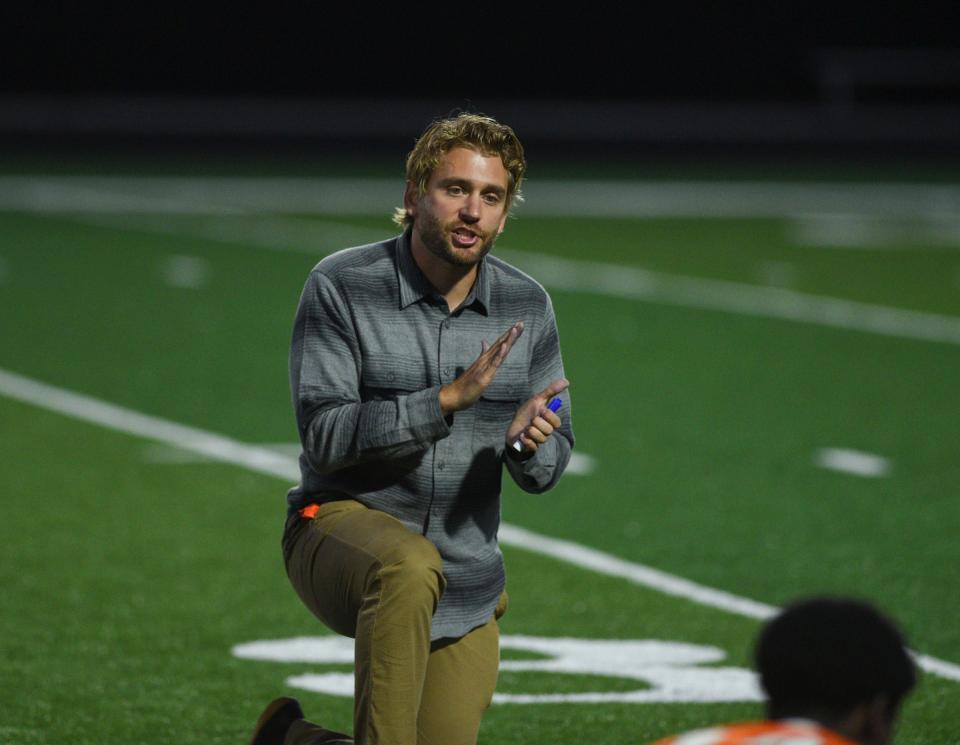Soccer’s popularity is growing fast in St. Cloud programs. How do clubs keep talent from leaving?
ABOUT THIS SERIES: "Growing the game: The rise of St. Cloud soccer" is a three-part series diving deep into soccer's evolution in the St. Cloud area.
ST. CLOUD — Central Minnesota soccer has experienced significant growth in recent decades, most notably in St. John's longevity at the collegiate level and St. Cloud Apollo High School's state title run detailed in part one.
But challenges have also arisen. Soccer is an ever-evolving game in the area, which means problem-solving can also feel like a moving target.
But one challenge always persists: How do you keep youth talent local?
That is always the first topic that comes up when you ask an area coach about what difficulties youth soccer faces.
And for good reason.
More:Soccer is gaining popularity in St. Cloud. Here’s why.

St. Cloud's proximity to the Twin Cities draws competitive players who want to play in college
The Minneapolis-St. Paul metro area's population stood at about 3.7 million in the 2020 census, about two-thirds of Minnesota's population. The St. Cloud metro area of Stearns and Benton counties sat at around 200,000.
With dozens and dozens of clubs in the Twin Cities, opportunities in an ultra-competitive market are easy to find. The main obstacle to entry is the hour-plus drive back and forth for training multiple times a week.
But that doesn't stop St. Cloud-area players from chasing that opportunity. Sartell senior captain Reese Kloetzer is one example.
Kloetzer first started playing soccer at the age of three in Ohio, instantly falling in love with the feeling of the ball at her feet. She moved to Minnesota in fifth grade, initially playing a few seasons in the Central Minnesota Youth Soccer Association.
In seventh grade she started playing for the Sartell High School team, and in eighth grade she began training with her longtime club Twin Cities Rush in Blaine.

"I wanted to play in the (Twin) Cities because I wanted more opportunities to get exposure in front of colleges and to venture out with other coaches and players," Kloetzer said. "More opportunities to play around the country and around the world."
Twin Cities Rush is just one club in the larger family of Rush clubs that extend worldwide, boasting more than 60 clubs in the United States and over 110 around the globe. Kloetzer plays year-round and has had chances to play with other elite Rush talent in Arizona, Pennsylvania and Sweden this year.
"The kids can be a part of Sartell soccer from the time they first lace up cleats at six years old all the way through their high school experience.”
- Roy Snyder, director of player development for Sartell Soccer Association
"That was awesome; best trip of my life," Kloetzer said about the 2022 Gothia Cup in Sweden. "We got to represent USA and walk the flag around the field in front of 46,000 people. Just the experience of playing other teams from around the world outside of the United States was incredible."
Kloetzer is currently weighing options to play Division I or Division II college soccer on the east coast, crediting her Rush club for her development as a player. She felt the resources and reach of a massive club like Rush was necessary for her to play soccer at the highest level.
"I've noticed tremendous growth just from playing club and then going straight into high school," she added. "I feel that bringing my skill into the high school level also helps other players around me get better. I also feel my leadership plays a role from my club."
Can Central Minnesota clubs accomplish the mission of building a soccer culture on the same scale as Minneapolis?
Can Central Minnesota clubs accomplish that same mission on a smaller scale?
Work is being done to make that a reality. Emily Willaert is the current director of coaching and player development for CMYSA, joining in 2015. The Mankato native played for the College of St. Benedict from 2007-11 and is entering year eight as an assistant coach on Steve Kimble's CSB staff.
The club has 25 travel teams from U9-U19, totaling nearly 1,000 kids with its recreation soccer programs included.
"As soccer grows in the area, they want to play at a higher and higher level," Willaert said about growth in travel teams. "As a club, we've established our developmental curriculum − what you're going to do at each age group. We've brought in a lot of the expertise of coaches in the area: St. Cloud State, St. John's, St. Ben's has players and coaches that will run clinics for us. That's been invaluable to our growth as a club."
More:What’s next for soccer in St. Cloud as the sport continues to grow in popularity?
CMYSA has also added two assistant directors of coaching: SCSU men's assistant coach Zach Neiberger and recent SCSU defender Eddie Saydee. Willaert said their passion and energy for the game is huge for the club's progress.
"They've both picked up a club team and taken on training responsibilities for our younger kids," she said. "Now at the U9 level, our kids are training with three college coaches. ... They train with us for 12 weeks throughout the year."

CMYSA used to be the only youth club in the area for decades, but that has changed. A St. Cloud suburb has their own club, the Sartell Soccer Association. A football-centric town is now home to the Cold Spring Soccer Club for rec and travel teams ranging from 4-14 years old.
“As our community becomes more diverse, I think soccer is a connection that brings everybody together.”
- St. Benedict head coach Steve Kimble
Roy Snyder, director of player development for Sartell Soccer Association, has also been the head girls soccer coach at Sartell High School since 2015. Developing talent at the youth level and keeping them within the club at older ages is a challenge Sartell faces just like CMYSA. Snyder wants Sartell Soccer Association to continue to grow so players don't feel the need to drive to Monticello or Blaine for competitive soccer.
"The kids can be a part of Sartell soccer from the time they first lace up cleats at six years old all the way through their high school experience. Hopefully that's special for them," Snyder said. "Do we have an environment where we can really challenge our elite players to continue to grow and still provide a good experience for (rec soocer)? Finding ways to balance that is a struggle."
Nearly every leader in the soccer community also cited a key area that is a necessity to spur growth: coaching education.
Many of the local college coaches have taken advantage of the extensive licensing system available for coaching. Extending that further to the high school level and the next generation of coaches will only raise the level of play.
"Good coaches develop good players; if you really want to grow the game, you've got to have people who are committed to learning to be really good coaches," Snyder said. "As more and more of our kids grow up playing high-level soccer and care about the game ... they come back and will be that next group of coaches.
"These kids will now have grown up playing soccer: that's a good foundation."

How can St. Cloud's diverse population be integrated into club play?
The St. Cloud area has become increasingly diverse in the past decade. Just take a look at the 2020 census data.
Over 10 years, every major community in the St. Cloud area saw its population of Black citizens grow by more than 100 percent. Waite Park went up 400 percent.
Remember Abdiaziz Handule, who played on the Apollo state team featured in part one? He came to St. Cloud from Somalia when he was 12, already deeply ingrained in soccer culture. He’d follow his older brothers to play anywhere they could, whether it was an open field or in a warehouse.
He still plays soccer often, happy to see the pickup games now trend younger with new faces joining in.
But Handule never had the chance to play on a local club team, playing only a year of U18 soccer on a premier team in the Twin Cities.

CMYSA is hoping to bridge that gap, getting talented local players who may not have had the opportunity in the past to get into the club at an early age.
“Our board right now is really committed to our financial assistance program, just trying to make soccer accessible to everyone in the area,” Willaert said. “When I first started we were giving out about $1,500 worth of financial aid, and now we average about $15,000. … It makes it easier to allow more kids to play since our price point is different.”
St. Cloud Tech and Apollo have seen large shifts in demographics at their respective high schools, something that could cause division. Instead, the schools have utilized their different soccer backgrounds for a common goal.
"Our biggest strength is that we have so many different players from different soccer and cultural backgrounds," Tech head coach Dan Stoterau said. "Everybody brings different knowledge and skills and style of play. We have a wide range of abilities. ... It makes it more fun. A real experience of getting to know people unlike ourselves.
"Coming together to achieve something great and working towards it ... (is) one of my favorite things about coaching in St. Cloud."
College of St. Benedict head coach Steve Kimble also believes soccer has come a long way in recent years, growth that can be partially attributed to the diverse population in St. Cloud.
“Soccer is such a global sport; they play in all kinds of countries,” Kimble said. “As our community becomes more diverse, I think soccer is a connection that brings everybody together.”

Can St. Cloud area facilities support the growth of the game - even in winter?
One of soccer's biggest challenges in Minnesota has always been Mother Nature. How do you get consistent, year-round play with snow covering the ground for nearly half the year?
Domes at St. John’s University and St. Cloud State help, especially for players looking for local winter training within their clubs.
Opportunities have also arisen due to construction at the College of St. Benedict and the opening of its outdoor athletic complex in 2018. The turf fields are now home to all of CMYSA’s league games, also bringing divisions of the youth state tournament to St. Joseph.
St. Cloud State’s Husky stadium also has plenty of soccer history, serving as the site of Apollo's state soccer title in 2014. It’s been the home for SCSU women's soccer since the 4,400-seat stadium was built in 2004.
But its main tenant was the SCSU football team.
The final home game of the 2019 SCSU football season saw the Huskies fall 24-13 to MSU-Moorhead on a November afternoon. Little did anybody know, that would be the final Division II football game played in St. Cloud.
Husky Stadium soon had an extra locker room available.
And a radical new project was on its way to shake up the St. Cloud sports landscape.
This is part two of a three-part series on soccer's evolution in the St. Cloud-Area. All three parts are subscriber-only content at sctimes.com.
Here's the remaining print publication schedule for "Growing the game: The rise of St. Cloud Soccer".
Sunday, August 28 — Part 1: Emergence
Monday, August 29 — Part 2: Challenges
Tuesday, August 30 — Part 3: Future
Support local journalism. Subscribe to sctimes.com today.
This article originally appeared on St. Cloud Times: St. Cloud clubs foster competitive soccer players, look for diversity

